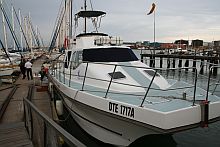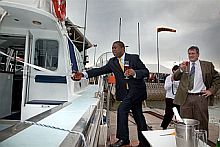Versatile new research vessel set to boost SA marine science
|
Inshore coastal research in South Africa has been limited owing to a lack of suitable vessels to undertake the required research.
South Africa’s research fleet consists mainly of large research ships that are expensive to run (upwards of R40 000 per day for the fuel costs alone) and are logistically very demanding.
Enter South Africa’s first 13-metre in-shore research vessel, which serves as a smaller, more versatile platform for a remotely operated vehicle (ROV). The research vessel is managed by the African Coelacanth Ecosystem Programme (ACEP).
The technologically advanced vessel is equipped with new physical and biological oceanographic equipment, including a state-of-the-art remotely operated vehicle which heralds a new era in research in South Africa's deepwater areas. This makes it ideal for coastal researchers who need to be out for 24 to 48 hours, and affordable to most researchers with individual research programme grants.
The vessel, which was funded by the Department of Science and Technology (DST), was launched at the Algoa Bay Yacht Club in Port Elizabeth on March 25.
In his keynote address, before formally launching and naming the research vessel, the Director General of DST, Dr Phil Mjwara, said that the isiXhosa name uKwabelana, which means "to share", was chosen for the vessel to make it clear that the research vessel is intended for use not only by ACEP, but by the broader scientific community.
The uKwabelana will be used on a collaborative basis by a number of researchers around the coast of South Africa. The ROV will also be made available to the rest of the South Western Indian Ocean region through ACEP’s partnership with the Agulhas and Somali Current Large Marine Ecosystems Project (ASCLME)
Dr Mjwara said that the DST decided to invest in the acquisition of this small research vessel with an ROV to provide ACEP and the broader South African research community with the ability to train more students, ultimately enabling the country to produce higher numbers of skilled scientists, technicians, communicators and educators.
"Students would be able to operate the ROV on this vessel and gather more underwater data without the requirements of diving skills," he explained, adding that the vessel would enhance the ability to do safer deepwater research beyond SCUBA depths.
A window to previously unexplored areas
According to SAEON Elwandle Node and ACEP Manager Dr Angus Paterson, the new boat and technology provided an ideal research platform and a window to areas of the South African and African coast that have never been explored.
"Whereas South African marine scientists could previously only gather information up to a depth of 30 metres by scuba diving, research observation now can be taken remotely to depths of up to 300 metres," he explained. The vessel is therefore expected to make a significant contribution to national and international marine research.
The vessel is fully equipped for overnight passages and is licensed as a Category A vessel that allows it to venture more than 40 nautical miles offshore. This enables marine scientists to sample the entire ecosystem (physical oceanography, marine geology, phytoplankton, zooplankton, infauna, fish, marine mammals and birds) from nearshore to past the continental shelf.
In conclusion, Dr Mjwara encouraged the scientific community not only to make use of the new research facility for their research purposes, but also to do everything they can to nurture her and ensure her long-term survival.
Related content:
Launch of exciting new ventures in marine research
Artificial reef monitoring in the iSimangaliso Wetland Park
SAEON's role in South Africa's science system
BACKGROUND:
The Department of Science and Technology (DST) made funding available to the African Coelacanth Ecosystem Programme (ACEP) to acquire a Remotely Operated Vehicle (ROV) and a coastal research platform (large ski-boat) from which to operate the ROV. . The research platform will be kitted out with the following scientific instruments:
- Acoustic Doppler Current Profiler (ADCP) to measure ocean currents
- Integrated GPS Echo-sounder to map the seafloor
- Davit and winch system to launch and retrieve scientific instruments, e.g. a. 80 micron mesh phytoplankton ring nets b. 90 micron mesh modified WP2 zooplankton net c. 100 and 200 micron mesh Bongo net to collect zooplankton and ichthyoplankton d. 60 micron mesh Plankton Pump e. Van Veen grab to collect sediment samples from the seafloor
- 4.Remotely Operated Vehicle (ROV) and flight panel in the cabin. The ROV will be equipped with: a. Cameras (two high resolution colour video cameras and one low light black and white camera) b. Sonar c. Ultra Short Baseline (USBL) navigation system d. 5-function manipulator arm to collect samples from the seafloor
- Compressor to fill SCUBA cylinders.
An operational platform is required to launch and retrieve an ROV during operations. The versatility and light weight of the Falcon ROV makes it possible to launch from smaller platforms than large and expensive research vessels. A suitably safe and stable operational platform is a large 13 m ski-boat. The advantages of a smaller launching platform are:
- cheaper operating costs (therefore more sustainable in the long term);
- more versatile (increased availability, shallower minimum working depth, increased maneuverability and accessibility);
The new acquisition is a valuable asset not only to ACEP but also to ASCLME and other national and international research programmes. Training scientists from the region on large modern research ships provides wonderful opportunities for the individuals, but they also need to train on a vessel that can be afforded by their governments and research institutions.




